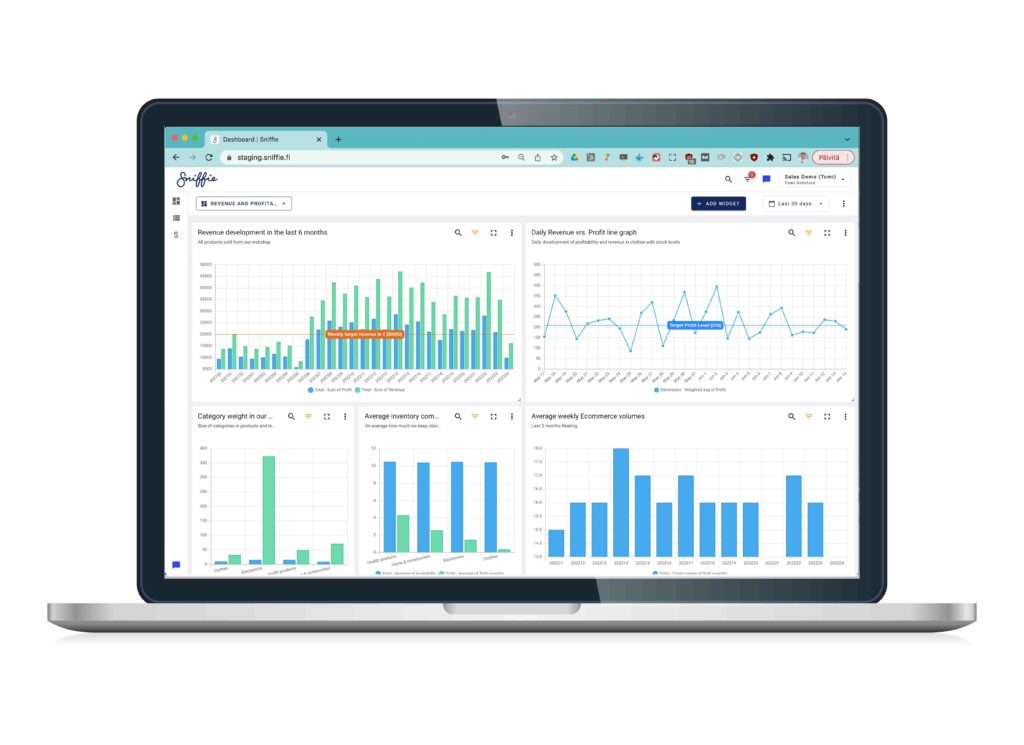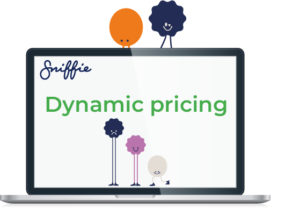This blog post will explain how to prepare for dynamic pricing in Ecommerce. In this article, we handle especially dynamic pricing in Ecommerce based on similar competitive products. First, we go through the main insights we have learned when helping different retailers and eCommerce companies set up dynamic pricing for their pricing strategy. Then we raise vital points you should focus on in your dynamic pricing implementation process.
Select products that benefit from dynamic pricing
Firstly, you should be aware of a concept called price elasticity. If your products are highly price sensitive, your consumers will most likely choose the lowest price on the market. This is especially the case if the price is relatively high. Let’s take an example. You are buying a refurbished Apple iPhone 13 5G 512GB. One outlet is selling it with 719€ and another with 829€. Even with the reliability, cost of shipping, branding etc. inluded, you most likely will buy the 719€ iPhone. Because the value for you isthe saving you make.
So, for you as a merchant it is important to first find those products from you catalogue that need to be kept in best possible price. The easiest way for you to understand which products to choose, you can analyze the competitor prices against your product sales volumes. If your volumes drop when a competitor is cheaper, you know your product is price sensitive. You can try first to match prices to see if your volumes pick up. Often your Key Value Items reflect this way. So map out the products that bring in the high volumes to put those into dynamic pricing.
You can leave other products into manual repricing, profit optimization, and run discounts with those. That way, you can optimize the profitability without competition dictating your prices for all your products.
Set a clear corridor for dynamic price changes
Let’s presume your price is 100 and your profit margin is 50. What should you do when your competitor sells at the same price and drops the price to 60? That is something you need to know in advance.
Creating a clear corridor (price floor and price ceiling) for the highest and lowest possible price point is essential when you do dynamic pricing. That way, you ensure you never set too high prices (your volumes drop dramatically) or too low prices (you won’t make any margins).
Start by setting a margin target for each product. Margin target is the minimum margin % you accept for the dynamic pricing to set your price to. When you analyze the company’s profitability, a high gross margin might be misleading. The only thing that matters is the classic formula for retail: volume X margin.
- Analyze first what the share of each of your product sales is from the total sales. The bigger the share, the bigger the importance.
- Then analyze how much you need to have minimum margin for the product to keep the volumes high.
- Then set clear margin targets for each product, so you do not give excessive discounts or lower the price too low.
For example if you have a Cost of Goods Sold 80€ and 20% margin target the lowest price is 100€ for your product. If you sell at 120, the corridor could have a price ceiling of 150 and a price floor of 75, and your dynamic pricing rules will never set lower prices than that.
Example on operating margin impact
Gross margin is the margin you will get from a single product. But let’s assume you sell only 100 products the entire year. You also have other costs like salaries, office, phones etc. If you were to sell the whole lot with your target price of 141€ your total annual turnover would be 14100€. For simplicity we can also estimate that all your costs would be 5000€ a year. So, your operating margin would be 2050€ ie. roughly 15%. See the breakdown below:
Turnover | 14100 | 100 % |
Costs | 7050 | |
Gross margin | 7050 | 50 % |
Other costs | 5000 | |
Operating margin | 2050 | 15 % |
This means that when you sell all your 100 tires, you make a 15% operating margin. But that means only if. In case you won’t, it’s a whole other ball game. Gross margin tells you what you are getting from a single sale. Operating margin is always relative to how well you perform sales, as it does have fixed costs included in the calculation. Those will always stay the same. Selling only 71 tires out of 100 tires and somehow noticing that the other 29 went bad or got lost, you are down to 0% on operating margin. One more and you are at a loss. Even with the 50% margin you are getting for each product.
Gross margin is a poor value to indicate your business performance. It only will tell you how much the margin is in one product. Listening to people who say they have a 200% margin is not just mad. It means you are following blind people in a dark forest. Your margin can, at highest, be only 99,99% or less. More importantly, no matter how high your gross margin is, your fixed costs should be the thing that dictates your pricing actions.
Need a Dynamic Pricing for Ecommerce?
Contact us and we will consult you on how to get started.

Create rules for the automation level
Automation makes life easy. But it might be a two-sided sword. Set clear pricing safeguards where your dynamic pricing can and cannot adjust prices. These boundaries should include following things:
- Keep below the market maximum
- Keep above market minimum
- Keep above your purchase price
- Keep above your margin target
- Do you need to confirm price changes manually
- Follow the Competitor Price Index
- Take into consideration the Days of Supply
- Follow product quality classes
- Take into consideration inventory
- How many times a day can the price be changed
By setting these boundaries, you ensure your automation is not working against you if the market goes too wild.
Make sure KVI products are either manually accepted or have tight automation policies to avoid loss
Using a dynamic pricing strategy, you must keep an eye on your Key Value Items. Mistakes in those products mean loss. Therefore we suggest that at least early on, you accept price suggestions manually and see how your demand forecast is developing.
Use gathered competitor campaign and availability details in your automation process to avoid loss and lost opportunities
Firstly, you Key Value Items should have even tighter automation policies. For example, you probably do not want to match competitors’ campaign prices. Secondly, those products might get further sales even when you raise prices if you are the only one selling those on the market.
A good policy, therefore, is that you should have early manual acceptance of those product prices and monitor competitor campaigns and availability. Your dynamic pricing software should be capable of collecting competitor campaigning and availability and turning it into action.
Create alternative actions in your automation when competitor actions offer opportunities
Dynamic pricing strategies are pretty straightforward. If something happens, then you react in a certain way. To capture the opportunities on the market, you can plan alternative actions. Create a set of alternative actions if and when your competitor gives you a case to do so. Having a low or no inventory is a no-brainer. Removing KVI’s that you two have in common will change the dynamics. So create ready-made alternative actions on how to act when something happens.
Set products that are in automation to set in right price level before major campaigning
Consumer rights have been in political discussion lately. And rightly so. Unfair commercial activities have been seen widely in campaigns like Black Friday. Raising a price to show a high comparison price is morally wrong if you do it a day before the campaign. But pricing is still your fundamental right as a retailer or eCommerce. Especially after the EU’s Omnibus Directive, you must plan your dynamic pricing. Dynamic pricing changes your prices every day. Noticing that your comparison price is too low before the campaign might be a big disappointment. So ensure you return your prices to a level you can still use in campaigns. Especially important if you are working in the EU. If you raise the prices for a campaign, you should do that 31 days before the campaign. Make sure you calculate the cost of these actions, as having a higher price might mean you lose the campaign profits in the 30 days prior. The best practice might then be to have different products in the campaign.
Create clear communication and action guidelines on communication if customer service received feedback on changed pricing
Some customers might react to your changing prices. That is only natural. The best policy is to write down clear guidelines for communication. Focusing on the fact that you try to offer the best possible price for the consumers is wise. Everyone understands that it is, in the end, for their benefit. But unclear, vague and unorganized communication is bad for business. Communicate your policy to the team and ensure the customer service has the tools to share that with your customers.
Make sure you only have one pricing master to avoid pricing mistakes
Dynamic pricing is suitable for businesses and consumers. But if you have several systems or people changing prices, you end up setting prices you didn’t intend to. So make sure you have one pricing master where all your price changes go to your eCommerce platform.
Hopefully these tips and the links we provided will help you to setup your dynamic pricing strategies and implement dynamic pricing to your organisation.
Get help from our resources
We have created free tools for eCommerce professionals that you download from our Resource Library. Get the tools to understand how to improve your pricing.



